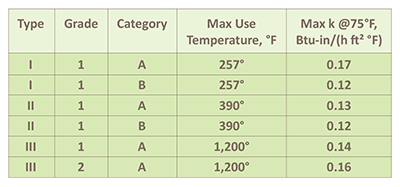Exploring Insulation Materials: Flexible Aerogel Insulation
Flexible aerogel insulation is a
composite of an amorphous silica-based aerogel cast into a fiber reinforcement.
The fiber reinforcement may consist of a batt, a needled felt blanket, or other
configurations of fibers. The fibers themselves may be inorganic, such as glass
fibers, or organic, such as polyethylene. The flexible aerogel insulation
typically contains hydrophobic agents and may also contain opacifiers.
Flexible aerogel insulation is
covered by ASTM C 1728. The standard covers material for operating temperatures
between -321°F and 1,200°F. Materials are classified by use temperature and by
thermal conductivity as follows: (see figure 1)
Type III, Grade 2 conductivities are
tested in pipe configuration.
The standard also contains
requirements for density, compressive resistance, surface burning
characteristics, exothermic temperature rise, linear shrinkage, sag resistance,
water retention, water vapor sorption, flexibility, corrosiveness to steel, and
fungi resistance.
Flexible aerogel insulations are
typically supplied in sheets ranging in thickness from 0.2 to 0.4 inches. Key
applications include original equipment manufacturer, pipeline, vessels, and
equipment in commercial and industrial applications.

